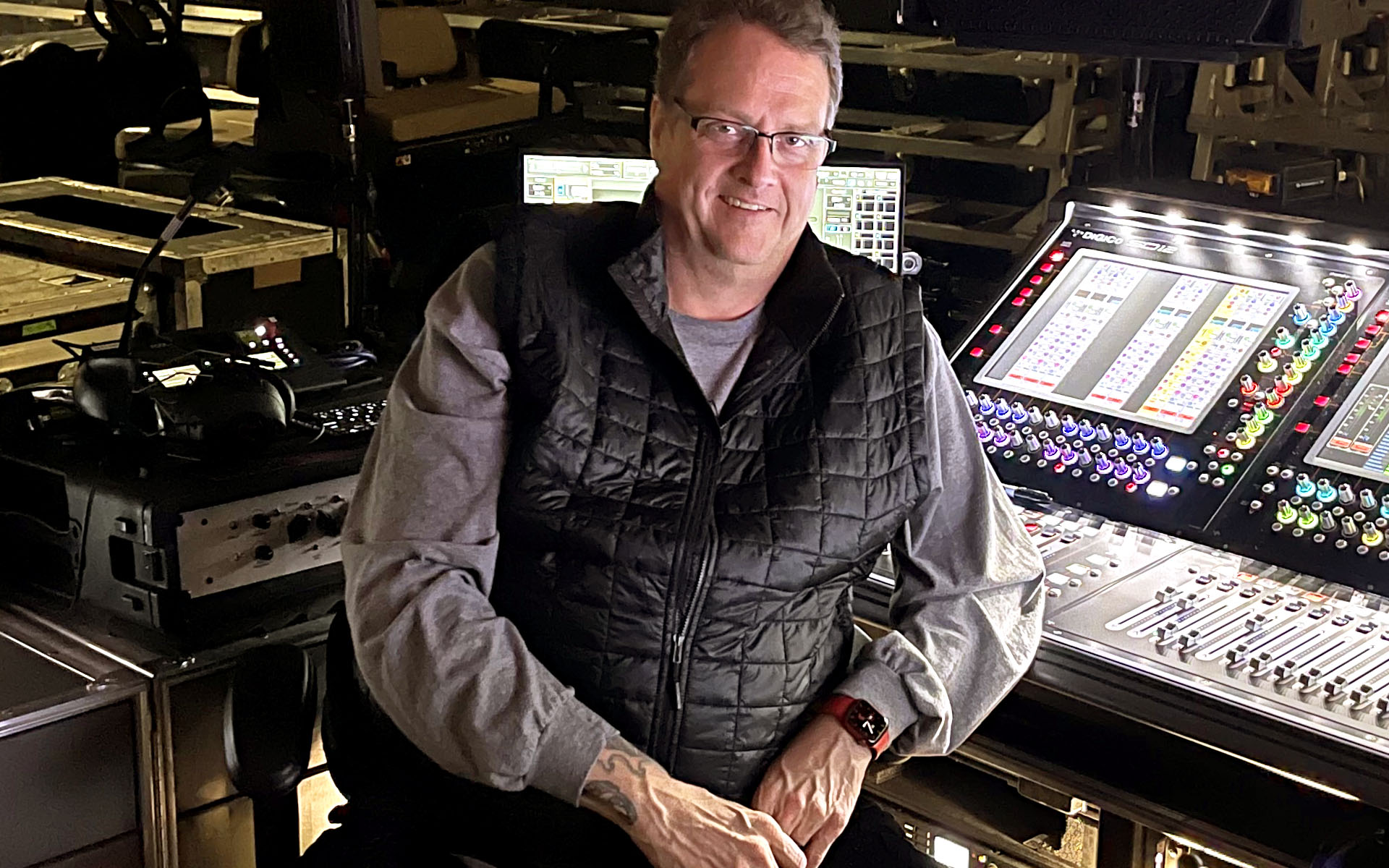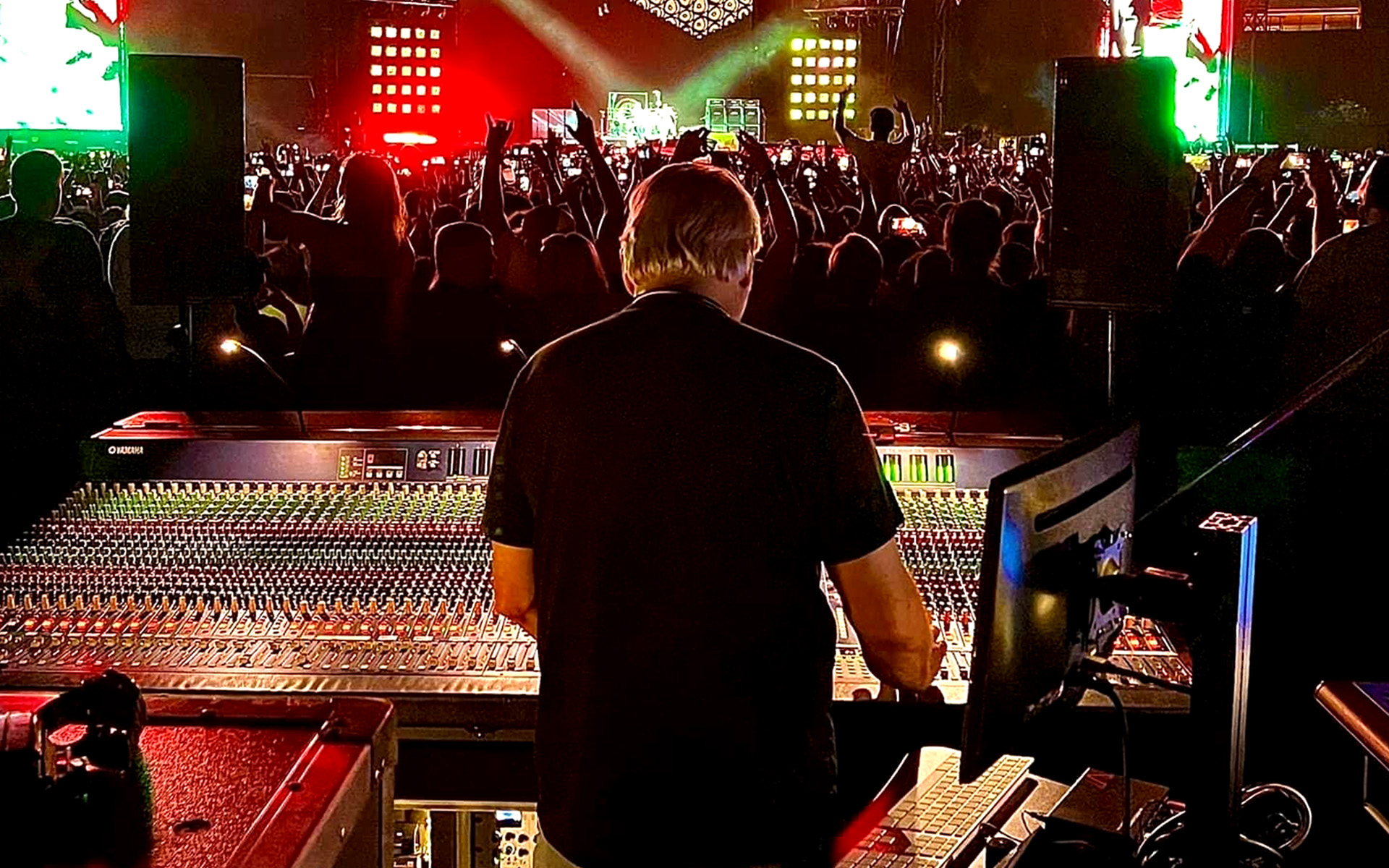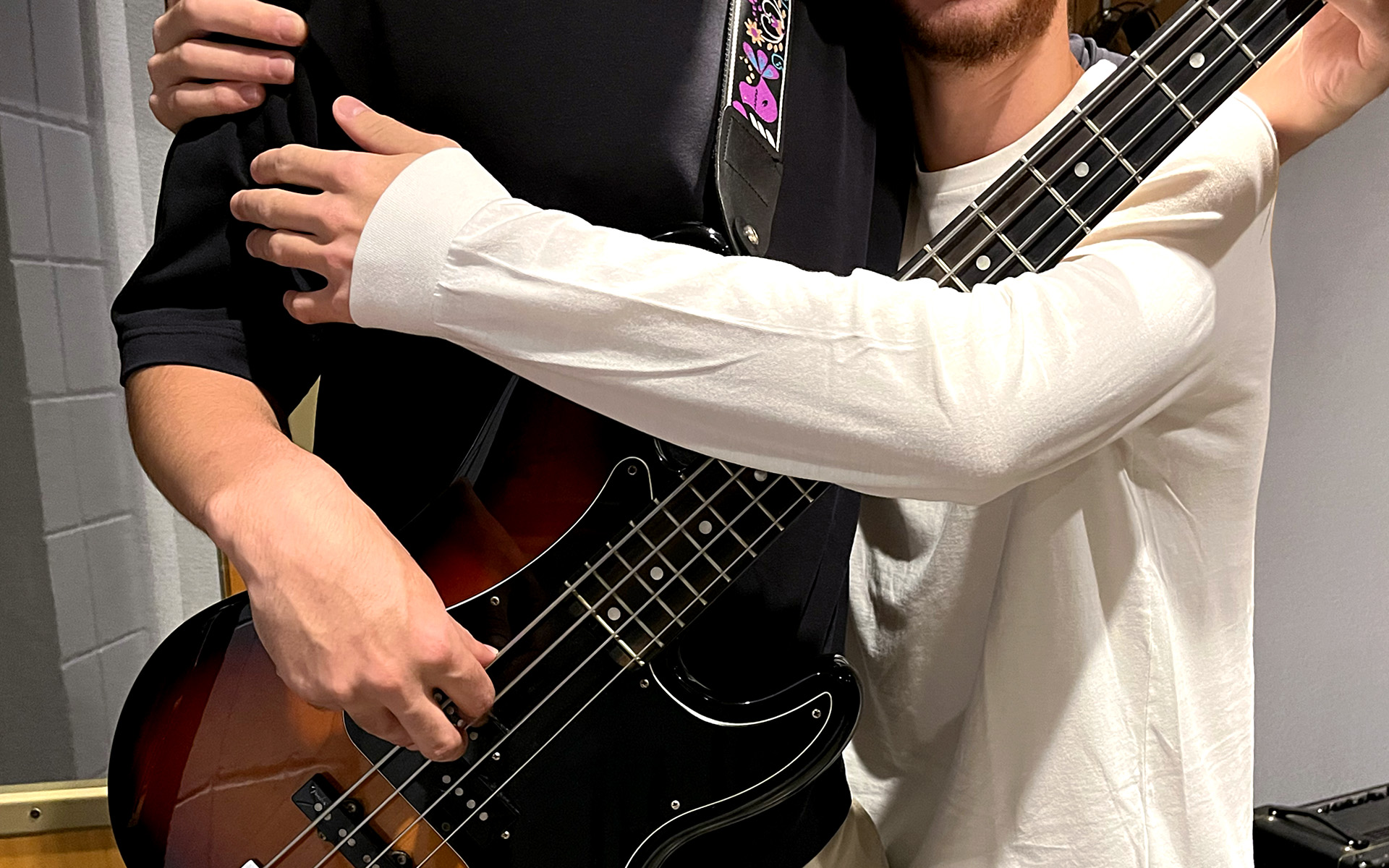The following information on being a live sound engineer—a personal account by Ken “Pooch” Van Druten—is excerpted from the Berklee Online course Microphone Techniques for Live Sound Production, co-authored by Pooch and Ben Cochran. The course is enrolling now.
The main comment I get when people find out I am a live sound engineer is “Your job must be so cool.” And it definitely is cool, but it’s probably not what you think it is. The job of the touring sound engineer is a good candidate for the internet meme of “What People Think I Do / What I Really Do.” The dream of hanging out with the musical elites, surrounded by pretty people, flying in private planes, partying late into the evening is not what my job is. My job is 18-hour days in imperfect conditions, horrible snack foods, (pizza and junk foods), and constant day-after-day repetition that is meant to break the faint of heart. The travel is hard: 22 hours in airplanes or buses, straight to the gig with no day off are commonplace. Some tours have almost no days off, for months on end. These are travel days where you finish loading out at 7 AM and travel eight hours to the next city, start loading in again, over and over and over.
While it may seem like I’m not painting such a great picture here—and make no mistake: I am not trying to deter you from your dreams—I am just pointing out that it is a hard life, and you must really want this job with all your heart while having a passionate drive for wanting to be better at it. It’s not the right choice for everyone. So what does my average day look like? On an arena or larger tour, you generally start at 6 AM. We walk into an arena that is completely empty: Nothing on the floor.

Rigging up the Equipment
Riggers are first to the floor, using chalk to mark out on the floor where steel cable and chain motors are going to lift the 100,000 pounds of gear (or more—the current tour I am on is 250,000 lbs) that are currently being held in the 53-foot trucks that are now arriving from last night’s gig. On average there are 10 to 20 of these trucks for an arena tour. We use temporary chain hoists to lift all this gear into the sky above the stage and audience. Lighting, Video, Pyro, and Sound all use chain motors (each rated for a certain amount of weight—1,000 lbs is the most common). The chains must be hoisted into the rafters of the roof by hand. They are heavy. It requires a tremendous amount of upper body strength and balance to pull the chain into the roof and secure it with wire rope around beams and whatever else is available. They use a lot of geometry and math to safely attach things to the building. A rigger’s job is thankless and hard, but often the most important on the road Once all the chains are in the air in their proper positions, we can begin to lift all the pieces necessary to do a show. In the audio department that means a lot of speakers.
Computer Prediction Software
I forgot to mention that while riggers are hoisting chains in the air and weights are being calculated, the audio system engineer is using computer prediction software to determine where the best placement for speakers are. This person builds a computer model of the arena space and every speaker manufacturer has a piece of software that helps you build a speaker system in a virtual space to predict what will happen with real speakers in place. It is very accurate. This software determines how many, where they go, and what angles the speaker boxes will be at to get the best result. Once this is computed, the riggers are made aware of where we need the chain motors to be located. There is no room for error. If one motor is not placed properly it could make for a horrible-sounding day. Things are checked again and again, not only for safety, but for accuracy. After this process is complete, speakers start to go up.
Connect Cables
Meanwhile, consoles are being set up at FOH and Monitors. There is quite a lot of cabling interconnect between gear at FOH and it takes time to set this up. Most people don’t realize that we disconnect and reconnect everything every day. Most of our cable is designed for long term misuse. Everything is designed to be the least number of connections, yet there are still on average more than 100 connections to be made at FOH and monitors, respectively. If any one of those cables or connectors gets damaged it could be a very long day. We protect them and try not to damage them when we load out.
Enroll in Microphone Techniques for Live Sound Production
Other departments are setting up as well and making all their connections. There is a cable dance that happens. Things that are last to be pulled at the end of the night are the first to get laid in the morning. Otherwise, the cable tangle and chaos would stop us in our tracks. So sometimes we wait for the lighting people to put their cable down first. There are very narrow windows of opportunity to get things done before another department needs to lay their cable over yours. It’s a ballet, often ending well … and sometimes not so well.
Set the Stage
The set pieces have begun to be built on the stage and the backline department is placing the drums and instruments in their proper places. It’s about 1 PM now and the day is slipping away from us fast. Once the musicians’ technicians have placed the instruments where they belong, they begin to check them and we as the sound department have to run stage cable and place microphones. This is one of the most crucial parts of our day.
Mic Placement
Since everything is torn down every day and packed away in its respective places, we must be very careful to unpack our microphones and place them in the same spots every day. Often, we use markings on the amplifier to help guide us to this spot and make it easier day after day.

Line Check
Once the microphones are properly placed and wired on the stage we start with a line check. This is something that we do as live sound engineers because every connection is unmade and made every day and we cannot guarantee that the connections have been made properly. At first, we do a thing called a “tap thru.” This is literally someone tapping on the side of every microphone to verify that the line is plugged into the correct spots. When doing so we are very careful not to damage the microphone by tapping on it too hard or tapping on the diaphragm itself. Just light taps on the side of the body can be heard with a pair of headphones and can verify that what the technician is tapping on is the expected place on the console.
Troubleshoot Broken Lines
If we discover it is incorrectly patched or we have a nonfunctioning line, there is an exact order of determining where the problem is. Always starting at the console we first verify that it is the microphone that is not broken (not common—but a definite possibility). We place the same type of microphone (one we know that functions) on the end of the first cable connected to the console (dynamic, condenser, etc). If it functions, we know that the problem is later in the chain. Then we go to the next connection, which is often the stage box (a metal box where many microphone cable connections meet).

If the microphone functions, then it must be the XLR cable that is plugged into the microphone at the source. Change the cable and hopefully this fixes our problem. We always do things in a very methodical order to determine as quickly as possible where we are experiencing a problem.
Test the PA
Once all the lines are sorted, we can concentrate on making sure the PA is in fully working order and we use measurement software called Smaart. This is computer software that displays the difference between the intended sound from the mixer and the received sound at the measurement microphone, and this real-time display informs the audio engineer’s decisions regarding delay times, equalization, and other sound system adjustment parameters.
Tune the PA and Virtual Soundcheck
Using delay to align components within the PA is vital in getting a good result and often takes several hours to make sure that every place in the arena is getting the same information. We listen using pink noise, which is random noise that has equal energy per octave (which is different from white noise, which has less energy in low frequencies) and we use music that we are familiar with to tune the PA. We also use something called virtual soundcheck. Virtual soundcheck is the act of recording the live multitrack files from a band either during a performance or during soundcheck and then playing those recorded files back through the console and down their respective channels.
Without having the band there, I can closely see what the band is going to sound like through the PA that night with the interaction of the room we are in. This is only something that has become available to engineers in the last 10 years or so and it really is an amazing tool. After all these things are complete it is usually about 5 PM or so. This is assuming that the day went smoothly. If we run into any sort of issues, we may end up working right up until concert goers are allowed in the building.
Take a Break
Normally we get a small break during this time, and we go have a meal in catering or try to take a quick nap because our day is not even half over.
There is a saying in the live event industry that the show is the thing that gets in the way of load in and load out. I think this is funny, but we truly do what we do because we love the joy we bring to audiences. There is no better feeling than being part of a show that people may talk about for the rest of their lives. Some shows are truly life changing for concertgoers and I am very proud to be part of that.
Pack Up
Once the show is complete, an immediate flurry of activity happens as we do everything we did all day in reverse. Things get packed up quickly and stored for use for tomorrow. It takes upwards of 11 hours to unpack everything and make sure it is all functioning, but only three hours to get it all packed away to travel to the next city.
By 2:30 AM we are usually driving away from the arena on our way to the next gig, where we will start all over again at 6 AM.
Generally, we do three of these days in a row before we have a day where we do not work. A lot of times the day “off” is a travel day where we are stuck on a tour bus for 12 to 14 hours.
As tours get bigger, time off is becoming a thing of the past. As I write this in November of 2023, I am on an arena tour with Travis Scott. We have a tremendous amount of gear: 32 trucks and 14 buses. We are hanging more than 250,000 lbs of equipment over the heads of the crowd. It takes a full two days to set the show up and a minimum of seven hours to load out. This means that there are many on this tour that do not have a day off for more than three months. That’s tough.
We all know what we are signing up for, and hopefully you remember to charge appropriately, but as far as mental health goes, we are not built as humans to work without time to decompress.
There are some downsides to this lifestyle, but the positives outweigh the negatives for most that decide to take this path. I can’t emphasize enough that there is nothing on this planet that compares to the feeling of being a part of something that thousands of people are cheering for. I remind myself on a regular basis that I am one of the luckiest people alive to be able to do something for work that I love. Most people dislike their jobs. I get to do something every single day that I have passion and adoration for. I wouldn’t trade it for the world, and I am blessed that I have friends and family that respect that, and understand how important my job is to me.
The factor that most don’t talk about is the toll it takes on the people you love. At the height of my career, I was away from home for 10 months (or more) a year. And this went on year after year after year.
If you have a partner and children, having a successful career as a live sound engineer effectively turns your spouse into a single parent. In my life I got to come home from a tour and show up as “fun dad,” where my wife had to take on the role of enforcer and control the kids with discipline and structure: not a role she wanted but one that she was given because of my absence. With this job, you are making sacrifices and so are your family members. I have missed important days in the life of my family: Births, first steps, weddings, baptisms, funerals, birthdays, holidays, etc.
The job of a touring FOH engineer can also be the most rewarding and exciting in its best moments. I have many memories of mixing large scale shows (125,000 people at a Rock in Rio festival comes to mind) where everything went right. It was an amazing show and the energy was infectious. I brought joy to thousands and was part of an overall presentation of a band’s vision. It still makes the hairs on my arms stand up to be part of a moment in a show during a guitar solo, for example.
The player is the one ripping it up there, playing an amazing solo, but you as an engineer are part of the moment by turning that up for the crowd. There is a direct reaction to you pushing a fader up and excitement as that solo is delivered to the crowd. There is no alcohol or drug that can replace this feeling. It has kept me coming back for more for 35 plus years.
About Pooch
Pooch is a tenured and acclaimed producer, engineer, and live sound engineer. His track record of recognition for flawless engineering started at Berklee College of Music and has continued through three Grammy nominations and a history of Platinum and Gold records. He is the FOH engineer and production master behind Jay-Z, Travis Scott, Justin Bieber, Iron Maiden, KISS, Guns N’ Roses, Linkin Park, and many more. He holds close to a dozen FOH engineer accolades.












